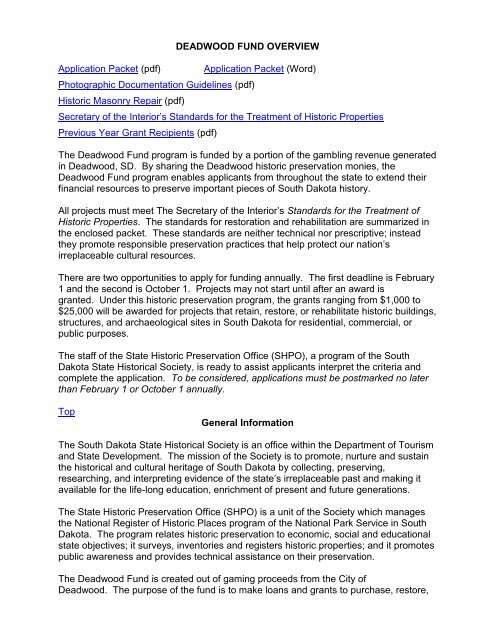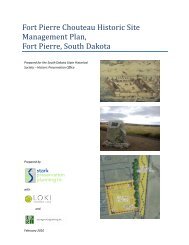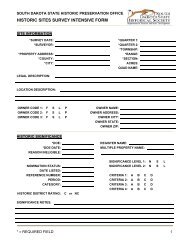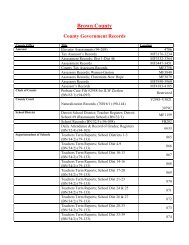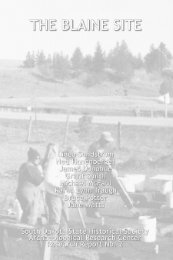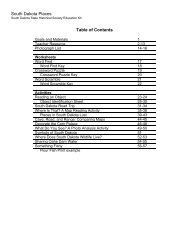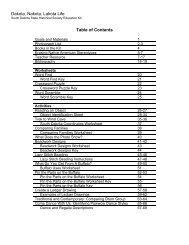Deadwood fund overview - South Dakota State Historical Society
Deadwood fund overview - South Dakota State Historical Society
Deadwood fund overview - South Dakota State Historical Society
You also want an ePaper? Increase the reach of your titles
YUMPU automatically turns print PDFs into web optimized ePapers that Google loves.
DEADWOOD FUND OVERVIEW<br />
Application Packet (pdf) Application Packet (Word)<br />
Photographic Documentation Guidelines (pdf)<br />
Historic Masonry Repair (pdf)<br />
Secretary of the Interior’s Standards for the Treatment of Historic Properties<br />
Previous Year Grant Recipients (pdf)<br />
The <strong>Deadwood</strong> Fund program is <strong>fund</strong>ed by a portion of the gambling revenue generated<br />
in <strong>Deadwood</strong>, SD. By sharing the <strong>Deadwood</strong> historic preservation monies, the<br />
<strong>Deadwood</strong> Fund program enables applicants from throughout the state to extend their<br />
financial resources to preserve important pieces of <strong>South</strong> <strong>Dakota</strong> history.<br />
All projects must meet The Secretary of the Interior’s Standards for the Treatment of<br />
Historic Properties. The standards for restoration and rehabilitation are summarized in<br />
the enclosed packet. These standards are neither technical nor prescriptive; instead<br />
they promote responsible preservation practices that help protect our nation’s<br />
irreplaceable cultural resources.<br />
There are two opportunities to apply for <strong>fund</strong>ing annually. The first deadline is February<br />
1 and the second is October 1. Projects may not start until after an award is<br />
granted. Under this historic preservation program, the grants ranging from $1,000 to<br />
$25,000 will be awarded for projects that retain, restore, or rehabilitate historic buildings,<br />
structures, and archaeological sites in <strong>South</strong> <strong>Dakota</strong> for residential, commercial, or<br />
public purposes.<br />
The staff of the <strong>State</strong> Historic Preservation Office (SHPO), a program of the <strong>South</strong><br />
<strong>Dakota</strong> <strong>State</strong> <strong>Historical</strong> <strong>Society</strong>, is ready to assist applicants interpret the criteria and<br />
complete the application. To be considered, applications must be postmarked no later<br />
than February 1 or October 1 annually.<br />
Top<br />
General Information<br />
The <strong>South</strong> <strong>Dakota</strong> <strong>State</strong> <strong>Historical</strong> <strong>Society</strong> is an office within the Department of Tourism<br />
and <strong>State</strong> Development. The mission of the <strong>Society</strong> is to promote, nurture and sustain<br />
the historical and cultural heritage of <strong>South</strong> <strong>Dakota</strong> by collecting, preserving,<br />
researching, and interpreting evidence of the state’s irreplaceable past and making it<br />
available for the life-long education, enrichment of present and future generations.<br />
The <strong>State</strong> Historic Preservation Office (SHPO) is a unit of the <strong>Society</strong> which manages<br />
the National Register of Historic Places program of the National Park Service in <strong>South</strong><br />
<strong>Dakota</strong>. The program relates historic preservation to economic, social and educational<br />
state objectives; it surveys, inventories and registers historic properties; and it promotes<br />
public awareness and provides technical assistance on their preservation.<br />
The <strong>Deadwood</strong> Fund is created out of gaming proceeds from the City of<br />
<strong>Deadwood</strong>. The purpose of the <strong>fund</strong> is to make loans and grants to purchase, restore,
or develop historic <strong>South</strong> <strong>Dakota</strong> properties for residential, commercial, or public<br />
purposes.
Individuals, organizations, and public agencies sponsoring projects to retain, restore or<br />
rehabilitate historic buildings, structures or sites by returning them to a state of utility,<br />
through repair or alteration, which makes possible an efficient contemporary use while<br />
preserving those portions and features of the properties which are significant to their<br />
historic, architectural, and cultural values and meeting the grant criteria are eligible to<br />
apply for a <strong>Deadwood</strong> Fund grant.<br />
In all instances, the burden of proving that <strong>fund</strong>s will support work in historic<br />
preservation lies with the applicant. Professional guidance by someone skilled in the<br />
retention, rehabilitation, and restoration of historic properties may be needed to<br />
successfully plan, implement, and complete a project. Evaluation criteria will be used<br />
as guidelines to rank each project. A project meeting all eligibility criteria does not<br />
guarantee that it will receive a grant award.<br />
A <strong>Deadwood</strong> Fund grant may be considered taxable income. In June 1997, the IRS<br />
began examinations of preservation grants in Colorado, and it claims that those grants<br />
are taxable income.<br />
Top<br />
Grant Information<br />
Grants will be for projects beginning approximately May 1 (following the February<br />
deadline) or January 1 (following the October deadline). Projects may not start until<br />
after notification of the grant award is received.<br />
Grants will generally be awarded in amounts ranging from $1,000 to $25,000.<br />
Where determined that an application merits support only in part or at a reduced level,<br />
the offer will be less than the amount requested. Larger grant awards may be<br />
considered in extreme circumstances.<br />
Generally, the grant amount requires a dollar-for-dollar match from non-federal and nonstate<br />
sources. The availability of matching <strong>fund</strong>s must be provided with the<br />
application. Nonprofit organizations according to state law may receive grants without<br />
match; however, match is highly encouraged.<br />
Payment of the grant award will be made on a reimbursement basis upon receipt of a<br />
paid invoice at the completion of the work. The matching <strong>fund</strong>s must be demonstrated<br />
at the time of payments. The <strong>State</strong> <strong>Historical</strong> Preservation Office staff reserves the right<br />
to inspect completed work before payment.<br />
Projects should demonstrate substantial public historic preservation benefits. The <strong>fund</strong><br />
will not pay for administrative or operating costs. The following categorical exclusions<br />
will not generally be <strong>fund</strong>ed with <strong>Deadwood</strong> Funds: security systems, general<br />
decorative arts and furnishings, general building or site maintenance, new construction<br />
or non-historic site improvements, and work performed only to meet the Americans with<br />
Disabilities Act and building codes.<br />
Top
Eligibility Criteria<br />
1. The property must be listed on or eligible for listing on the National Register of<br />
Historic Places.<br />
2. The project must meet The Secretary of the Interior’s Standards for the Treatment of<br />
Historic Properties: Rehabilitation (36 CFR 67).<br />
3. The applicant must demonstrate that <strong>fund</strong>s are available to match the grant, and the<br />
property will have on-going use at the completion of the project for residential,<br />
commercial, or public purposes.<br />
4. The applicant must provide assurances of the ability to maintain the property well<br />
into the future.<br />
5. The applicant must sign an eight-year restrictive covenant running with the property,<br />
which states that the property shall be maintained in a manner that preserves the<br />
property’s historic integrity. All work performed on the property within the covenant<br />
period must meet The Secretary of the Interior’s Standards for the Treatment of Historic<br />
Properties: Rehabilitation.<br />
6. A sign provided by the <strong>South</strong> <strong>Dakota</strong> <strong>State</strong> <strong>Historical</strong> <strong>Society</strong> must be posted at the<br />
project site. The sign will state that the project has been <strong>fund</strong>ed in part by the <strong>State</strong><br />
<strong>Historical</strong> <strong>Society</strong> through the <strong>Deadwood</strong> Fund and must remain posted for the duration<br />
of the project. All publicity material should include similar recognition.<br />
Top<br />
Evaluation Criteria<br />
The <strong>Deadwood</strong> Fund grant program provides an opportunity to leverage financial<br />
resources for the acquisition, retention, restoration or rehabilitation of historic buildings,<br />
structures and sites. Awards in this program are made only when there is evident need<br />
for additional <strong>fund</strong>s to complete a critical project and to effect significant improvement or<br />
prevent losses of historic properties. The applicant must demonstrate a financial<br />
investment in the project, the ability to meet the financial obligation, and a commitment<br />
to its completion.<br />
Projects will be ranked for priority based on the following criteria:<br />
1. The property is significant to <strong>South</strong> <strong>Dakota</strong> history and the project substantially<br />
benefits historic preservation and serves as a major public demonstration of historic<br />
preservation.<br />
2. The historic building, structure or site is of public prominence or importance and is<br />
endangered or threatened.<br />
3. The entire project meets the Secretary of the Interior’s Standards for the Treatment<br />
of Historic Properties: Rehabilitation.<br />
4. The property is associated with minority or ethnic groups, particularly American<br />
Indians.
5. The property is currently listed on the National Register of Historic Places.<br />
6. The project has a preservation plan in place and documented community support.<br />
7. The property receives appropriate on-going maintenance, or its present state of<br />
disrepair is not the result of neglect by the current owner.<br />
8. The applicant documents more than the required dollar-for-dollar match; nonprofit<br />
organizations providing match.<br />
9. The application is clear, concise, complete, and includes a detailed budget.<br />
10. A historic preservation professional assisted in developing or reviewed the project,<br />
the general contractor and subcontractors are professionally qualified and preservation<br />
sensitive, and if the work is being completed by someone other than a licensed<br />
contractor, the individual or company is capable of performing the prescribed work.<br />
11. The project has not previously received <strong>fund</strong>ing through this program.<br />
The applicant is encouraged to be a member of the <strong>South</strong> <strong>Dakota</strong> <strong>State</strong> <strong>Historical</strong><br />
<strong>Society</strong> and Preserve <strong>South</strong> <strong>Dakota</strong>.<br />
Top<br />
Description of Review Process<br />
Applications are accepted any time, but all eligible applications must be postmarked no<br />
later than February 1 or October 1 each year to be considered in the current year<br />
cycle. An applicant must submit an application for each deadline. Applications will not<br />
be forwarded to the next application deadline.<br />
Each application is assigned to a historic preservation specialist, usually based on the<br />
geographic location of the project. The specialist reviews the application for<br />
completeness and to ensure that the project is eligible for consideration. If the specialist<br />
requires additional information to process the application, he or she will call or write the<br />
applicant.<br />
An in-house review panel evaluates each application/project based on the criteria listed<br />
above. The SHPO staff makes formal recommendations to the <strong>South</strong> <strong>Dakota</strong> <strong>State</strong><br />
<strong>Historical</strong> <strong>Society</strong> Board of Trustees and other key personnel. The Board makes a final<br />
determination on applications in April and December.<br />
The <strong>State</strong> Historic Preservation Officer will notify each applicant about the disposition of<br />
the awards within 90 days of the final review by the Board of Trustees.<br />
Top


